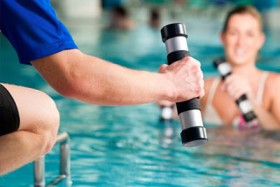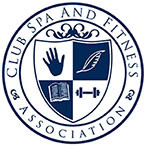Aquatic Therapy and Certification
To those suffering with pain and immobility, fitness therapy is an invaluable source of relief. Whereas a physical therapist’s job is to facilitate immediate recovery for the injured, a fitness therapist’s work picks up where physical therapy leaves off—going beyond injury recovery to help individuals regain a normal level of functioning fitness. Fitness therapy helps people who have sustained immobilizing injuries, as well as people who suffer from disabilities and chronic pain. Fitness therapists use many different strategies to ease pain, increase mobility and improve the livelihood of their patients. Aquatic therapy is one of them.
Aquatic therapy, as the name indicates, uses treatments performed in the water for therapeutic benefit. When submerged in water, the human body’s natural buoyancy reduces gravitational pull and lessens the impact on the body that exists with movement on solid ground. Coupled with water’s intrinsic ability to slow movement, water therapy is a viable option for rehabilitation. In many cases, aquatic therapy helps lead to faster progress and healing because of the reduced stress and ease of movement for ailing bodies.
To onlookers, aquatic therapy may look like mere floating and slowly moving around in the water, but it’s much more than that. Aquatic therapy is led by a certified aquatic therapist and involves defined techniques and exercises.
What does it take to become a certified aquatic therapist?
Typically, aquatic therapists are certified fitness or physical therapists first, and obtain additional certification in aquatic therapy to supplement land-based therapies. A person interested in expanding into the aquatic therapy niche should:
- Have a love of being in the water and a desire to help others overcome impairments or manage disabilities
- Be certified as a fitness trainer or therapist, physical therapist, occupational therapist, or other credentialed health care professional
- Obtain certification in aquatic therapy through the Aquatic Therapy and Rehab Institute (ATRI).
ATRI certification is currently the only professional certification specifically for aquatic therapy. ATRI certification is designed to ensure that an individual understands ATRI’s standards for aquatic therapy and is competent in delivering aquatic therapy to patients. The prerequisite for taking the ATRI certification exam includes completion of 15 hours of education in aquatic therapy, rehabilitation or aquatic therapeutic exercise education, which can be achieved through hands-on learning or online courses. With the prerequisite met, the exam tests on the six components of the ATRI Standards for the Aquatic Industry, which include movement mechanics and science, aquatic principles and methodologies, professional responsibilities, and an understanding of safety and legal considerations.
As with any fitness therapy specialty, earning an aquatic therapy certification takes expertise, commitment, and a passion for employing unique forms of treatment to improve the lives of others. Aquatic therapy is not only physically beneficial for its recipients, but it’s known to be an emotionally rewarding career for its practitioners as well.
Aquatic therapy professionals should take care to protect their professional well-being with a personal Professional Liability Insurance policy. Regardless of any coverage offered through a fitness facility, hospital or any other health care center, a personal insurance policy protects you from the liabilities of providing health care services, regardless of where the services are rendered. Learn more about Lockton Fitness Professional Liability Insurance.
Customer Feedback
-
Thank you so much for your prompt response. Might I add, Veronica was a delight to work with and her professionalism and attention to detail made this an overall pleasurable experience.

Earl W.




















